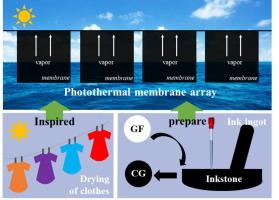中国墨纳米流体制备太阳能双向界面蒸发光热膜
IF 13.2
1区 工程技术
Q1 ENGINEERING, CHEMICAL
引用次数: 0
摘要
太阳能蒸汽发电有潜力解决淡水短缺和全球能源危机的双重挑战。传统的光热膜仍然面临蒸发效率低、耐用性差等挑战。受室外晾晒衣服的启发,该研究报告了一种新的双向界面蒸发器,通过垂直放置光热膜。通过热传导传递到光热膜另一侧的热量几乎完全被重复利用。在1 kW/m−2(- |-)太阳辐照下,双向界面蒸发器的蒸发速率为1.91 kg m−2h−1。因此,由于双向蒸发效应,垂直放置的蒸发器的蒸发效率比传统水平放置的蒸发器提高了35.5% %。采用墨锭研磨法制备中国墨纳米流体溶液,可有效提高光热膜的耐久性。因此,光热膜在10个循环中保持稳定的蒸发速率。因此,这些优点导致了高效、耐用和直接的光热膜用于清洁水的生产。本文章由计算机程序翻译,如有差异,请以英文原文为准。

Photothermal membrane fabricated by Chinese ink nanofluid for solar bi-directional interface evaporation
Solar steam generation has the potential to address the dual challenges of freshwater shortage and global energy crisis. Traditional photothermal membranes still face challenges such as low evaporation efficiency and poor durability. Inspired by the outdoor drying of clothes, the study reports a new bi-directional interface evaporator by vertically placing a photothermal membrane. The heat transferred to the opposite side of the photothermal membrane via thermal conduction is almost entirely reused. And the bi-directional interface evaporator can achieve an evaporation rate of 1.91 kg m−2h−1 under 1 kW/m−2(−|-) solar irradiation. Consequently, the evaporation efficiency of the vertically placed evaporator has increased by 35.5 % compared to traditional horizontally placed evaporators due to the bi-directional evaporating effect. The durability of the photothermal membrane made from Chinese ink nanofluids solution prepared by grinding ink ingots can be effectively improved. Consequently, the photothermal membrane maintains a stable evaporation rate over 10 cycles. Therefore, these advantages result in an efficient, durable, and straightforward photothermal membrane for clean water production.
求助全文
通过发布文献求助,成功后即可免费获取论文全文。
去求助
来源期刊

Chemical Engineering Journal
工程技术-工程:化工
CiteScore
21.70
自引率
9.30%
发文量
6781
审稿时长
2.4 months
期刊介绍:
The Chemical Engineering Journal is an international research journal that invites contributions of original and novel fundamental research. It aims to provide an international platform for presenting original fundamental research, interpretative reviews, and discussions on new developments in chemical engineering. The journal welcomes papers that describe novel theory and its practical application, as well as those that demonstrate the transfer of techniques from other disciplines. It also welcomes reports on carefully conducted experimental work that is soundly interpreted. The main focus of the journal is on original and rigorous research results that have broad significance. The Catalysis section within the Chemical Engineering Journal focuses specifically on Experimental and Theoretical studies in the fields of heterogeneous catalysis, molecular catalysis, and biocatalysis. These studies have industrial impact on various sectors such as chemicals, energy, materials, foods, healthcare, and environmental protection.
 求助内容:
求助内容: 应助结果提醒方式:
应助结果提醒方式:


